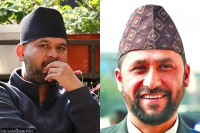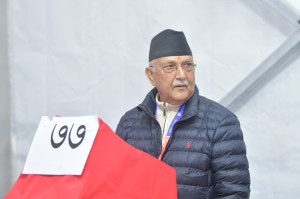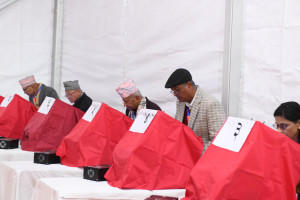Politics
Machination or mistake? Resham Chaudhary’s brief arrest raises eyebrows
Police detained Resham Chaudhary from a Janamat-NUP merger event Wednesday only to release him later after the Supreme Court voided the arrest warrant citing a court official’s error.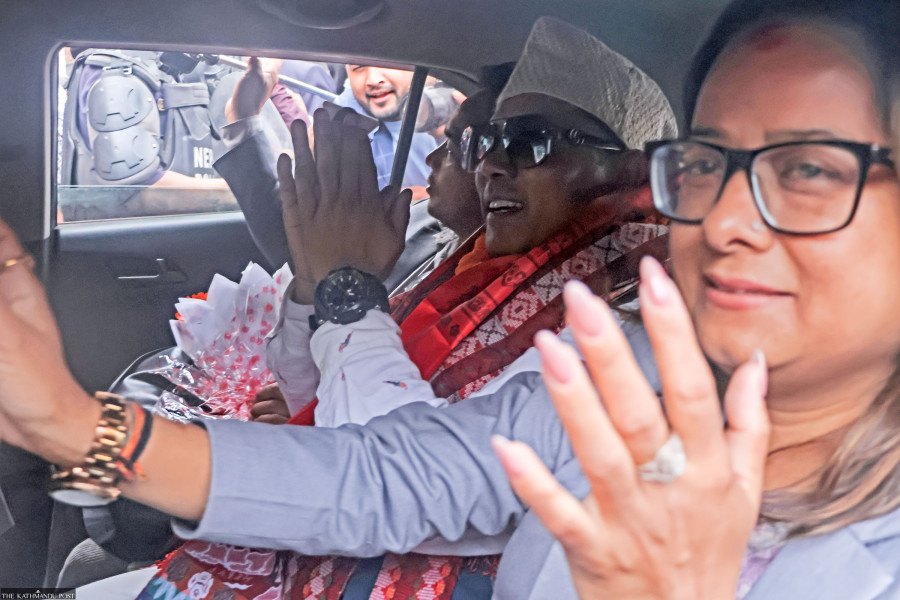
Purushottam Poudel
A dramatic turn of events left many people bewildered for around five hours on Wednesday afternoon.
Leaders and cadres of Janamat Party and Nagarik Unmukti Party (NUP), among others, had gathered on the premises of the Nepal Academy at Kamaladi in Kathmandu to attend an event to announce unification between the CK Raut-led Janamat and Ranjita Shrestha-headed Nagarik Unmukti.
But, out of nowhere, a team of plainclothes policemen wearing helmets suddenly whisked away Resham Chaudhary, the patron of Nagarik Unmukti, from the event as other leaders and cadres from the two parties were busy preparing the stage for the function.
“The arrest resembled a kidnapping,” Sharad Singh Yadav, Janamat spokesperson, told the Post from the academy premises minutes after the arrest. Yet, in a bewildering turn of events, Chaudhary was released only a few hours later—also by court order.
Police made the arrest on the basis of a letter they had received from the Supreme Court. It concerned the 2015 Tikapur massacre.
On August 24, 2015, there were violent protests during the Tharuhat movement, which demanded a separate province for Tharu-majority areas, and Akhanda Sudurpaschim movement, which called for an undivided farwest. This was right before the promulgation of the constitution of Nepal in September of the same year. On the day, at least nine individuals, including Nepal Police SSP Laxman Neupane and a two-year-old toddler, had died.
Chaudhary, who was found to be the main perpetrator of the crime, was sentenced to life imprisonment by courts—from the district level up to the Supreme Court.
However, on the recommendation of the government, President Ramchandra Paudel granted him a pardon on May 28, 2023, on the occasion of the Republic Day. On the Cabinet’s recommendation, President Paudel pardoned the remaining jail terms of 501 convicts, including Chaudhary.
Soon after Chaudhary’s arrest on Wednesday, the Supreme Court ruled that the arrest warrant was unauthorised. Following an internal investigation, another letter was sent to the prison authorities and the police, instructing them not to enforce the earlier warrant, according to Supreme Court spokesman Achyut Kuinkel.
Mahiman Singh Bista, a section officer at the court who had sent the letter to Dillibazar Prison instructing Chaudhary’s arrest, was taken into custody. He was arrested by police from the court premises and taken to the District Police Office at Bhadrakali. According to a police official, Bista was detained as the letter issued in his name was deemed suspicious and legally invalid.
“After a letter was sent to the police on a sub judice case, we immediately issued another letter to rectify the situation,” Kuinkel said. “An internal investigation is currently underway to determine how such a letter was issued in the first place.”
Minister of Law Ajay Kumar Chaurasiya, under whose jurisdiction the Supreme Court falls, described Chaudhary’s arrest as a human error. While acknowledging that the incident happened due to a mistake by a court official, the minister also expressed scepticism, stating a junior officer was unlikely to issue an arrest letter without informing a superior.
“I feel there may be an element of personal vendetta in this incident,” the minister told the Post.
The police, for their part, stated that their duty is to act upon the directives issued by relevant authorities. According to police officials, Wednesday’s incident happened because of a faulty directive.
However, Kathmandu District Police Range spokesperson Apil Raj Bohora said that they do not believe the order to arrest Chaudhary came at the behest of any external force.
“The individual who issued the letter is currently in our custody,” he said. “On Thursday, we will seek an extension to keep him in custody for further investigation, after which we will begin taking his statement. We believe more details will emerge during the quizzing process.”
Meanwhile, NUP president Ranjita Shrestha stated that the police had acted on the basis of a court letter, and that Chaudhary was released after a subsequent letter clarified that the initial one was erroneous.
“After an error was found in the letter issued by the Supreme Court ordering the arrest of Chaudhary, the court itself rectified the mistake,” Shrestha told the Post.
She also said that the party unification process, which was disrupted on Wednesday, would proceed within a few days.
But Janamat Party chair Raut termed Chaudhary’s arrest a major conspiracy.
Raut alleged that the apex court official who issued the letter ordering the arrest was only a ‘pawn’, and that the incident was orchestrated from higher levels.
“The official was made a scapegoat,” Raut told journalists following Chaudhary’s release. “I can only express my sympathies for him. This was directed from the very top.”
Following Chaudhary’s arrest, NUP supporters protested vehemently, shouting slogans against the government.
Both parties view Chaudhary’s arrest on the day of the planned unification announcement with suspicion, with their leaders expressing doubt about the timing of the arrest. While Raut claimed a high-level conspiracy, he did not specify which authority was behind it.
However, Supreme Court spokesperson Kuinkel rejected the notion that the court could have been influenced by external forces. “We too are trying to understand how the error happened,” he stated.
Within the NUP, there had long been tensions between patron Chaudhary and party president Shrestha over the party’s internal operations. More recently, disagreements also surfaced over the planned party unification. In the initial stages, Shrestha expressed reservations about her role in the newly formed party structure.
Under the proposed arrangement, Chaudhary was to remain as patron, Raut was to be the chair of the new party, while Shrestha was to take the third-ranking position. During the initial stages of the unification process, Shrestha had told the Post that her role was ‘yet to be finalised’, suggesting that she had reservations with the position offered to her. Shrestha eventually agreed to take the third position.
The two parties are currently ruling coalition partners, although NUP has only a minister of state in the federal government.
Even though Janamat Party holds no position in the federal government, its leader Satish Kumar Singh leads the Madhesh Province government with the backing of the two major ruling parties, the Nepali Congress and the CPN-UML.
Despite expressing dissatisfaction with the ruling alliance following Wednesday’s incident, both parties have yet to make a decision on whether to withdraw their support to the government. According to Lalbir Chaudhary, a lawmaker and leader of the NUP, the party is yet to adopt a formal position on the matter.
Meanwhile, Abdul Khan, vice president of the Janamat Party, stated that as the Supreme Court itself had acknowledged a mistake and had already released Chaudhary, the government cannot be accused of acting with bias or hostility. He also clarified that there has been no discussion on withdrawing the party's support to the current government.
Janamt and NUP leaders stated that the party unification programme, which was disrupted on Wednesday, will now be held after a few days.




 16.12°C Kathmandu
16.12°C Kathmandu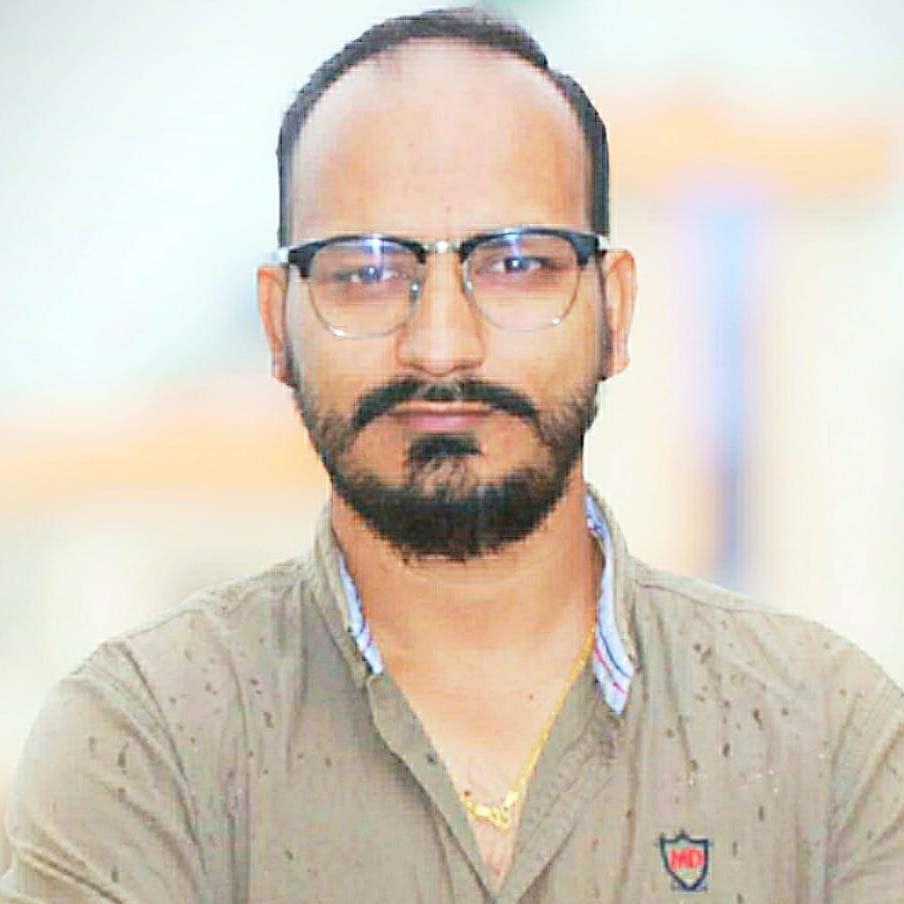


.jpg&w=200&height=120)
